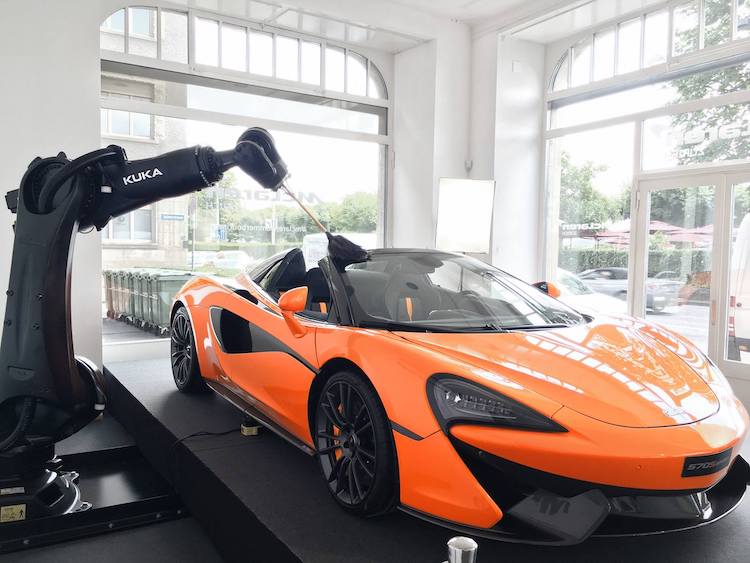
Kuka revises financial forecasts because of economic slowdown
Company says it will redirect investment towards “smaller and simpler robot systems” as well as collaborative robots
Kuka has revised its financial forecasts for the fiscal year 2018 because of the “economic slowdown”, which could at least in part refer to the US-China trade dispute.
The industrial robot maker says the “challenging market environment” is the result of a slowdown in the “key industries of automotive and electronics, weak growth in the important Chinese market as well as challenges in the project business”.
Kuka says it has implemented an “immediate package” to strengthen future viability. And it is adjusting its forecast for the past fiscal year 2018.
The company expects revenue of approximately €3.2 billion and a gross profit margin – before purchase price allocations, investments in growth and reorganization expenditure – of approximately 3.0 percent.
Kuka had already reduced its original forecast in October 2018 and had assumed then that it would generate a revenue of approximately €3.3 billion and a profit margin of approximately 4.5 percent.
In view of that, the Executive Board no longer regards the achievement of the targets for Vision 2020 formulated in 2015 as realistic.
Those targets envisaged a revenue of between €4 billion and €4.5 billion and a target profit margin of more than 7.5 percent.
Kuka will publish the 2018 financial statements, including the forecast for 2019, at its annual press conference on March 28, 2019.
This development is mainly due to the following factors: the increasingly noticeable general economic slowdown since the fourth quarter of 2018.
This slowdown impacts two important business segments: the electronics industry as well as the automotive sector, in which Kuka earns half of its revenue.
There is also slower growth in China, one of the key markets for robotics. The current growth rates in China have not been so low since the financial crisis. In addition, there were unforeseeable risks from the project business.
To ensure the future viability and long-term sustained profitable growth of the company, Kuka’s executive board has passed a “comprehensive immediate package” covering four key areas:
an efficiency program focusing on indirect areas such as administration, sourcing, sales and project management;
a German-Chinese task force to ramp up the Chinese joint ventures and the development of specific products for the Asian market;
the focusing of research and development investments with shorter development cycles; and
a more customer-focused and less centralized organizational structure.
Kuka’s newly appointed CEO, Peter Mohnen, says: “The investor agreement with Midea guarantees KUKA’s independence until 2023.
“In the long term, however, it is above all our performance that secures us. In order to boost that, we are taking prompt action. That’s in the interests of our customers and our employees worldwide.
“We are sticking to our ongoing investments because they form the basis of our innovative strength, on which our customers place their trust. Between 2018 and 2020, we will invest over €500 million – more than ever before.”
Savings in indirect areas, among others Kuka’s strong growth in the past years – from €900 million to €3.5 billion in revenue since 2009 – has caused a sharp increase in costs as well as some inefficiencies.
In order to counter that, Kuka is launching an efficiency program that aims to save a total of more than €300 million in costs by 2021. A substantial part of these savings is to be achieved as early as 2019.
Drivers include administration, sales, sourcing and project management. The efficiency program will also include personnel measures.
In order to leverage the full potential of the cooperation with Midea, a new position has been created at both Kuka and Midea and filled with specialists who have intercultural experience.
The joint task force will coordinate the joint ventures and promote product development. The task force reports directly to the Kuka CEO.
The Chinese robotics market remains a key growth driver for Kuka, despite the economic slowdown.
Kuka, therefore, plans to expand the product portfolio and the production capacities in China to cater better for the specific needs of the Asian market.
The focus is on smaller and simpler robot systems, such as Scara and Delta robots for the electronics market.
Kuka will continue to invest strongly in research and development in the future, but will focus more strongly and accelerate the development cycle. As before, annual funds of around five percent of revenue are earmarked for that.
In the future, however, these funds will be directed more towards focus projects, including mobile robots, collaborative robots and Industry 4.0 applications.
As a result of its equity interest in the Munich-based company Device Insight, an internet of things company, Kuka has extensive experience in handling more than a million connected devices and analyzing the corresponding data.
That experience will be applied to industrial processes to an even greater extent in the future.
In order to cope with its strong international growth, Kuka has centralized numerous structures since 2012 – including IT, human resources, finance and marketing. This is to be maintained.
Kuka is also sticking to its tried-and-tested principle of a central contact person for every customer.
As part of service delivery itself, however, Kuka intends to rely on the decentralized areas of robotics, systems engineering and logistics.
Many discussions with customers and an internal evaluation have revealed that such an approach makes sense.
Mohnen says: “The state of the economy is not in our own hands, but we can adjust important internal levers. That’s exactly what we’re doing with our immediate package.
“We’re building on our strengths and working relentlessly on our weaknesses. In doing so, we focus on our customers; we save where necessary and invest in our innovativeness.”


